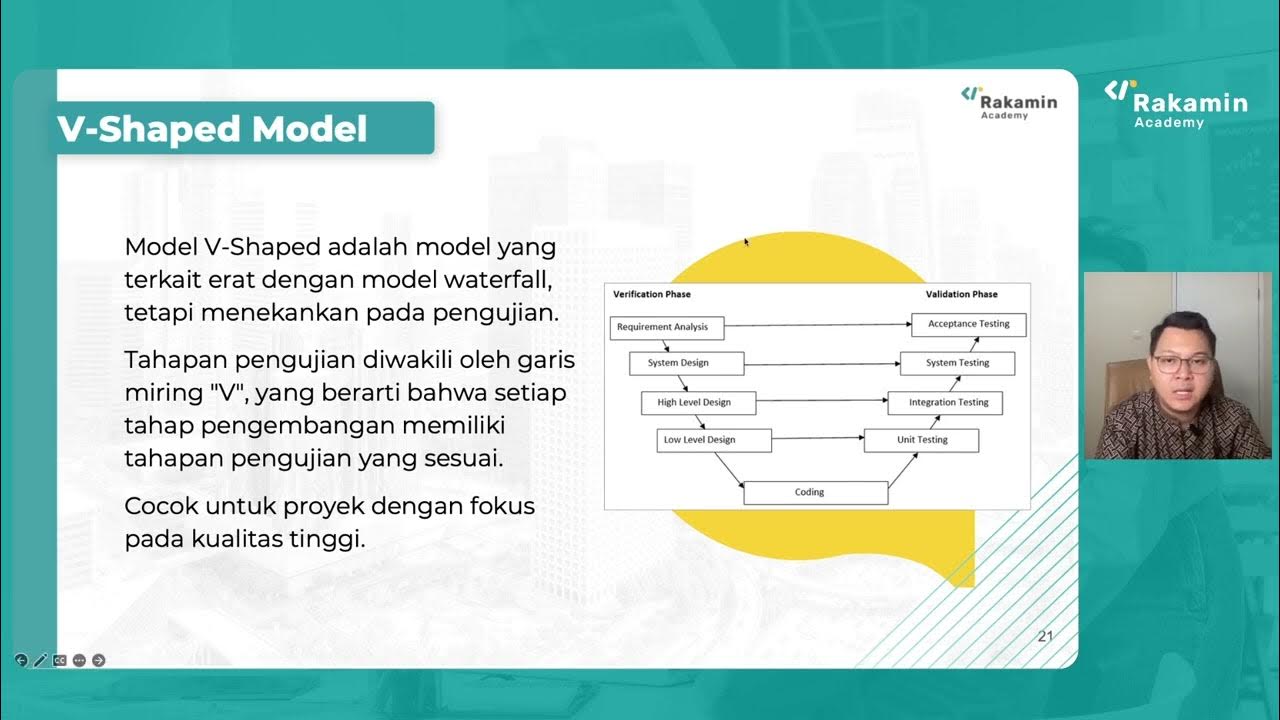Lesson 2 Software Development Life Cycle (SDLC) Iterative Model || CodeLikeLD Tagalog Discussion
Summary
TLDRThe transcript discusses the incremental model of software development, explaining how each increment involves analysis, design, coding, and testing. The first increment serves as a base for subsequent versions, with additional requirements and features added progressively. This model allows flexibility, faster development, and cost-effectiveness compared to others. However, it emphasizes the importance of completing each phase without overlap and notes challenges related to system architecture, as not all requirements are gathered initially. Despite its benefits, potential issues may arise due to incomplete requirements in early stages.
Takeaways
- 💡 Incremental model involves building software in small, manageable increments rather than gathering all requirements upfront.
- 🔄 Each increment involves analysis, design, coding, and testing, which is reused in the following increment.
- 🚀 Multiple prototypes are created through each increment to improve and perfect the program.
- 🛠️ Incremental development allows for flexibility as new features are added with each phase.
- ⚖️ The model is cost-effective, as changes in the development stage can be made with less expense compared to other models.
- 🔍 Each phase of an increment is rigid and does not overlap with other phases, ensuring clear boundaries between stages.
- ❗ Challenges may arise due to incomplete requirements at the start, which could affect the overall system architecture.
- 🔧 The first increment's output is essential for subsequent increments, as it builds the foundation for further development.
- 📈 Incremental models are quick to generate usable software early on, making them efficient for initial versions.
- 🏗️ The iterative nature of the model allows continuous improvement, but it requires a thorough understanding of early requirements to avoid rework later.
Q & A
What is an incremental model in software development?
-An incremental model is a development approach where the software is built in increments or versions. Each increment adds new functionality to the existing product, which allows for flexible and cost-effective development.
How does the first increment of development work in an incremental model?
-The first increment starts with gathering initial requirements and developing a basic version of the software. This version is then used as the foundation for future increments, where more features and improvements are added.
Why is the incremental model considered flexible?
-The incremental model is flexible because it allows for adjustments to be made between increments. New requirements can be added as each increment builds upon the previous one, allowing the system to evolve over time.
What are the main stages of each increment in the incremental model?
-Each increment involves analysis, design, coding, and testing. After one increment is complete, the process repeats with additional analysis, coding, and testing for the next increment.
What are the potential issues with the incremental model regarding system architecture?
-Problems can arise with the system architecture because not all requirements are gathered upfront. This can lead to challenges in ensuring the architecture supports future increments without significant modifications.
How does the incremental model compare to other development models in terms of cost?
-The incremental model is generally less costly compared to other models because changes can be made incrementally without having to overhaul the entire system. It also reduces the risk of rework.
Why is the incremental model less rigid compared to other models?
-The incremental model is less rigid because it allows for changes between increments. Unlike models where each phase must be completed fully before moving on, the incremental model allows for iterative improvements.
How does the incremental model handle overlapping phases of development?
-In the incremental model, phases do not overlap. Each increment must be completed before moving on to the next. This structured approach allows for better control and tracking of progress.
What are the advantages of using the incremental model?
-The incremental model provides flexibility, allows for early partial implementations, reduces cost, and gives room for gradual improvements, making it suitable for projects with evolving requirements.
How does the incremental model help in quickly generating a working version of the software?
-The incremental model allows a basic working version to be developed quickly, which can then be improved in subsequent iterations. This ensures that a functional product is available early in the development cycle.
Outlines

Dieser Bereich ist nur für Premium-Benutzer verfügbar. Bitte führen Sie ein Upgrade durch, um auf diesen Abschnitt zuzugreifen.
Upgrade durchführenMindmap

Dieser Bereich ist nur für Premium-Benutzer verfügbar. Bitte führen Sie ein Upgrade durch, um auf diesen Abschnitt zuzugreifen.
Upgrade durchführenKeywords

Dieser Bereich ist nur für Premium-Benutzer verfügbar. Bitte führen Sie ein Upgrade durch, um auf diesen Abschnitt zuzugreifen.
Upgrade durchführenHighlights

Dieser Bereich ist nur für Premium-Benutzer verfügbar. Bitte führen Sie ein Upgrade durch, um auf diesen Abschnitt zuzugreifen.
Upgrade durchführenTranscripts

Dieser Bereich ist nur für Premium-Benutzer verfügbar. Bitte führen Sie ein Upgrade durch, um auf diesen Abschnitt zuzugreifen.
Upgrade durchführenWeitere ähnliche Videos ansehen

Classic Waterfall model in Software Engineering

Evolutionary Model with real life examples | Software Engineering

SE 5 : Iterative Development Model | Complete Explanation | Software Engineering

Lecture 10: Incremental Model

Sub Topic 2

ISTQB FOUNDATION 4.0 | Tutorial 15 | Test Levels | System Testing | CTFL Tutorials | TM Square
5.0 / 5 (0 votes)
